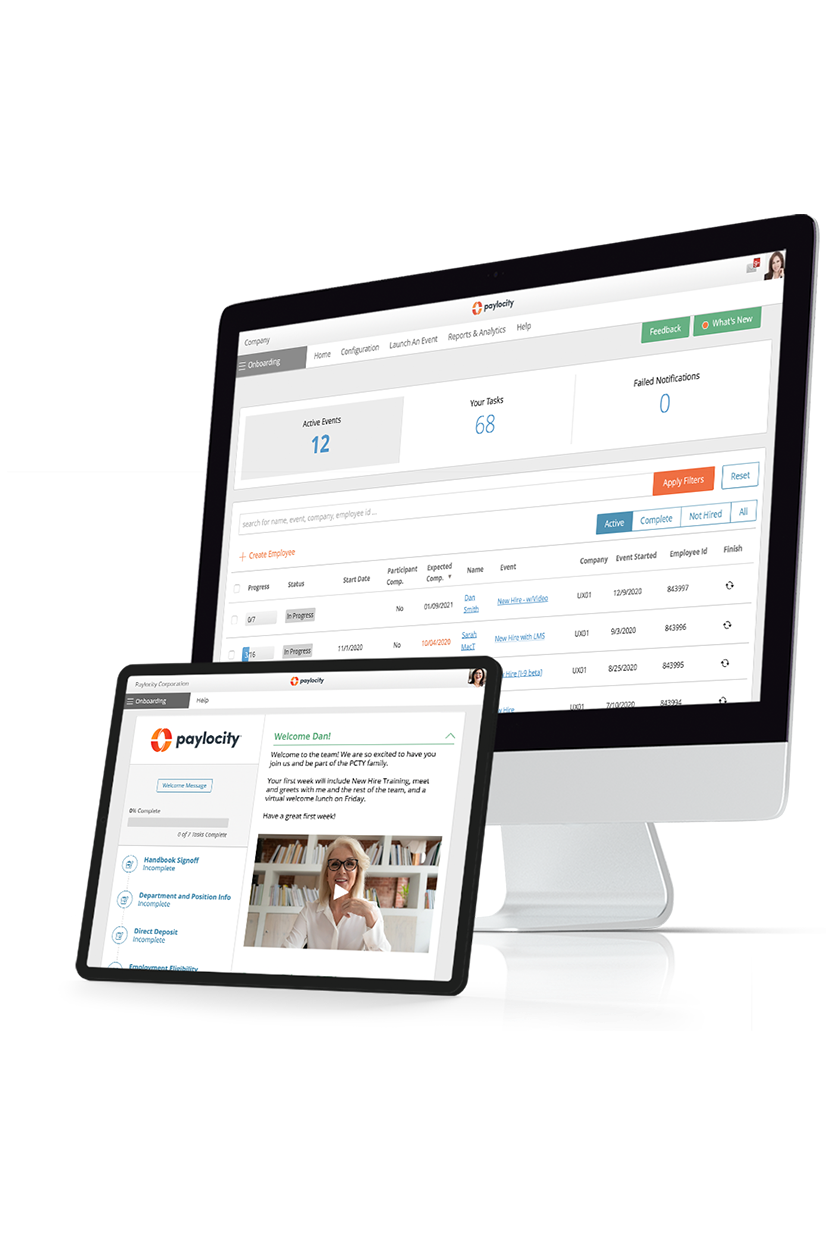resources
Onboarding Checklist for New Employees in 2024
October 16, 2023

Onboarding shouldn’t be just about paperwork — it should be about people.
Sure, there are obligatory tasks, like collecting required documents and ordering computer equipment. But an effective, modern onboarding process aims to build a strong foundation for a long-lasting relationship between employees and your company.
Although there is no one-size-fits-all formula for implementing a great onboarding experience, a checklist is always a good place to start. We got that for you here, along with tips on how you can engage new hires in each phase of the onboarding process.
Let’s get on board!
What Is an Employee Onboarding Checklist?
An employee onboarding checklist is a guide for helping new hires acclimate to their workplace. It includes a list of administrative tasks and orientation activities to be completed during the onboarding process.
Using a checklist helps HR maintain consistency for each new hire and reduces the likelihood that important paperwork or orientation tasks will slip through the cracks.
But remember: Simply checking off items doesn’t equal success. The best onboarding process tackles the routine while still delicately handling each new hire’s unique situation and role.
The Essential New Hire Onboarding Checklist (+ Bonus Tips!)
One of the great things about checklists is that they free up brain space for more creative or relational activities.
You can offload remembering the mundane (but necessary) items, and dedicate more time to meeting your new hire and showcasing company culture.
There’s a lot of steps to onboarding, so We’ve broken down our onboarding checklist into three key phases: 1) preboarding, 2) orientation, and 3) training. Along with each, we’ve included implementation tips and opportunities to leverage modern HR and payroll technology.
Read the checklist below, or download the PDF version.
Phase 1: Setting New Hires Up for Success During Preboarding
As soon as an employee signs the offer letter, the preboarding period begins. This phase is an opportunity to knock out the necessary paperwork required for new hires to start work on day one. It’s also your first chance to engage new employees and build excitement about joining your organization.
Preboarding Checklist
- Send the job offer email and collect the signed offer letter
- Send a welcome email after the employee returns the offer letter that provides:
- Start date and manager name
- A list of documents to complete before the start date
- Any physical documents that the employee needs to bring on their first day
- What to expect on day one — this might include parking information for onsite employees, an agenda, dress code, lunch details, etc.
- Whom to contact with questions prior to their start date
- Request that the employee complete and submit any required hiring documents:
- I-9 (verifies identity and eligibility to work in the US)
- W-4 (indicates withholdings for federal tax compliance)
- State and local tax withholding forms
- Direct deposit form
- Permission to conduct background check
- Employee handbook acknowledgment
- Emergency contact information
- Submit equipment requests, which may include:
- Computer
- Phone
- Safety gear
- Security badge, ID, and/or office key
- Announce the new employee to the company and/or team
Tip: The Preboarding Workflow
Leveraging an integrated HR and payroll solution that links recruiting and onboarding functions not only streamlines the transition from applicant to new hire, it ensures no detail is missed. Specific actions trigger the next event in the onboarding sequence. As forms are submitted, notifications automatically set essential tasks in motion, like alerting payroll when direct deposit information is submitted.
Tip: How Welcoming Is Your Welcome?
A fast way to turn off a new hire is by sending a generic welcome email with a list of things they have to do before they even start work. Be sure to personalize your communications with the employee’s name and the relevant details about their role. A great way to show new hires how much your organization values employees is to include a welcoming video message from your CEO or another company leader.
Phase 2: Designing Orientation with Retention in Mind
Orientation is your time to start getting new hires settled at your organization. The when, where, and how it’s conducted depends on a number of factors, like whether employees are onsite or how many people are in the session. But the why of orientation doesn’t change: to provide new employees a foundation for success in their new job.
Orientation Checklist
- Go over the agenda and any housekeeping items for the orientation session
- Collect any outstanding new-hire paperwork
- Ensure all access credentials and logins work for the employee
- Introduce your company mission and values
- Explain benefits and the enrollment period
- Review the employee handbook and essential policies, such as:
- Safety
- Information security
- Data privacy
- Diversity, equity, inclusion, and accessibility
- Arrange a tour of the facilities or a virtual meet and greet with the team
- Schedule time for the new employee to meet 1:1 with their manager
- Build in activities to help new employees bond with one another
- Hand out or ship some swag!
Tip: How to Make Remote Employees Feel Connected
Nearly half of employees who joined companies during the pandemic went through remote onboarding. Employees who joined a company post-pandemic are the most at risk of disengagement and turnover, with only 52.5% feeling highly engaged. Here are some ways to connect with remote employees during orientation:
- Send a welcome package to remote employees’ homes with some company merch and any onboarding materials they may need.
- Start orientation off with a live Q&A with your computer team to make sure new employees are comfortable with their equipment and logins.
- Do activities in small-group breakout sessions so new employees have a chance to get to know each other.
- Invite guest speakers from across the organization to share their career stories and provide additional exposure to your company and culture.
- Schedule regular breaks to avoid screen fatigue.
Phase 3: Training and Ongoing Development
Following orientation, some employees may enter a formal training program while others will get on-the-job training. But while new hires are usually eager to get to work, that doesn’t mean they aren’t thinking about their future. Spend some time during orientation to talk about goal setting and the career advancement opportunities your organization offers. Employees who strongly agree they have a clear plan for their professional development are 3.5 times more likely to strongly agree that their onboarding process was exceptional.
Training and Development Checklist
- Assign any compliance policy training that employees must complete
- Send a survey to assess how new employees felt about their orientation experience
- Touch base with people managers to evaluate how effective orientation was in preparing new employees
- Invite new employees to join a peer group on your internal communication hub
- Schedule 30-60-90-day check-ins between employees and managers
- Send periodic employee satisfaction surveys with questions like:
- Do you feel your job role and responsibilities are clearly defined?
- Do you have the resources you need to be successful in your job?
- Do you feel valued for your contributions?
- Do you feel connected to your coworkers?
- What types of learning and development resources are most helpful to you?
- Remind managers when six-month and one-year anniversaries are coming up
Tip: Set a Course for Employee Success
Fostering a culture of learning helps keep employees planning for their future with your company. A learning management system (LMS) simplifies corporate training, helps you monitor learning progress across the organization, and empowers employees to pursue the skills and career paths that are most important to them.
New Hire Onboarding Documents and Paperwork
Use this checklist to make sure you provide your new hire with all the necessary onboarding documentation:
- Job offer letter
- Employment contract
- I-9
- W-4
- Direct deposit form
- State and local tax documents
- Emergency contact information form
- Employee handbook
- Organizational hierarchy chart
The right HRIS software can make distributing crucial paperwork and collecting signatures easy. Consider investing in an HR solution with an onboarding platform for easy paperless document management and onboarding workflows.
The Benefits of Employee Onboarding Software
When a new hire signs their offer letter, the onboarding clock starts ticking. By using onboarding software, HR teams can significantly reduce paperwork, giving them more time to focus on providing a people-centered experience.
An effective onboarding solution results in easier workflows and better communication, helping new employees connect more quickly with their coworkers and your company.
It’s no secret that an engaged employee is a productive one. Successful onboarding can have a big impact on the bottom line by fostering early engagement, increasing productivity, and ultimately reducing turnover.
Check out our new employee onboarding guide for a full breakdown of everything you need to know about building a world-class onboarding program.

Make Your First Impression Count
An impactful employee experience begins before day one. Make data collection, tax paperwork, and direct deposit setup seamless so you can begin engaging your new employees immediately with our onboarding tool. Help make your new hire’s first day memorable in the best way possible with less process and more human connection.


